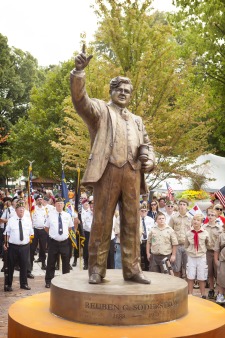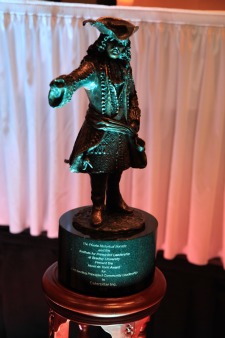“First, you have to think about what you want to say. Then you research and research, and talk to people… You read and sketch and think and think and think. And half of the work is not even visible… People don’t always realize that.”
For Lonnie Stewart, a sculpture is so much more than a passive rendering in bronze or clay; it’s a living tribute to the object of depiction. He pours hundreds of hours into each piece, his meticulous craftsmanship matched by a remarkable research process that leaves no stone unturned on the quest for his subjects’ true essence.
Midwest’s Native Sons
Stewart, of course, is the celebrated painter and sculptor who splits his time between Peoria and Charleston, South Carolina, when he’s not traveling the world on an endless series of fact-finding missions. World-renowned for his portraits of Mother Theresa, Pope John Paul II and Princess Diana, Stewart keeps a studio in downtown Peoria, but has lately been working out of a facility in East Peoria, where the ceiling is tall enough to contain his nine-foot bronze of the great literary icon, Galesburg’s own Carl Sandburg (1878-1967).
A Galesburg native himself, it’s fitting that Stewart is behind this statue, which will soon tower over the city’s public square. “Growing up, everyone talked about Carl Sandburg,” he recalls. “His aunt lived very close to my grandparents. I may have even seen him as a child… who knows?”
Though already well familiar with the writer’s legacy, Stewart immersed himself in Sandburg’s world, reading every book he could get his hands on and traveling all over the country, interviewing scholars and others who knew the man. “You have to be [thorough]. I want to represent him as who he was.”
One of the difficult things about posthumous works, he says, is that “you must rely on photographs and videos for your information. And that requires viewing the subject from all angles, not just the face.” To that end, Stewart poured over hundreds of images of Sandburg to get his physical features just right.
“There are all kinds of elements you pick up when you’re looking through photographs,” he says, thumbing through a well-worn copy of a Sandburg biography. “There are characteristics that identify Carl Sandburg very easily: his hair—the way it would lay flatly against his skull—his face, his stance… He was pigeon-toed. When he stood, he would stand on both feet equally; he wouldn’t lean on one foot or the other. And he was muscular—all through his life, he worked out every day.”
Accoutrements & Essence
But Lonnie Stewart always digs deeper than the surface, going to great lengths to find the inner core of his subjects. In Sandburg’s case, that meant looking beyond his Pulitzer Prize-winning poetry and prose to his wife’s prize-winning goat farm at Connemara, the North Carolina estate where he spent the last two decades of his life.
“He and his wife had three herds of goats,” Stewart explains, “and they were instrumental in introducing goat milk products into America. He was always with goats. When people came to Connemara, he would put one in their laps, whether they liked it or not!”
And Sandburg’s love for the species was lifelong, says Stewart. “I heard about the goats when I was a kid. When he lived in Galesburg, his aunt had goats, and he was always playing with them.” After painting Nellie, a floppy-eared descendent of Sandburg’s original Nubian herd at Connemara, Stewart chose to include the creature in his bronze depiction.
“Knowing that he loved them so much,” he says, “I thought it was appropriate… not only because it shows his love for animals… It’s also a symbol of the unity in his marriage—the happiness that centered around these goats, his children and his wife.”
With the beloved goat at his feet, the bronze Sandburg clutches two books in his left hand—one of his volumes on Lincoln, and a collection of poems—with his cherished Swedish guitar strapped across his back. “He had five or six of these guitars… I measured and photographed them at Connemara as well. He would sing all the time… He wrote an amazing, voluminous amount of songs all through his life.
“I feel that [Sandburg] would be pleased,” says Stewart of the nearly-completed statue. “I have everything in there that he likes.”
 Labors of Love
Labors of Love
The same exhaustive research can be found in Stewart’s portrait of Reuben G. Soderstom (1888-1970), the union leader and legislator who was pivotal in developing Illinois’ modern labor laws. In September, Stewart’s eight-foot bronze statue of the great orator was erected in Soderstrom’s hometown of Streator, where it is surrounded by 14 tablets memorializing some of his greatest quotes.
To prepare for this work, the artist again sifted through hundreds of photographs—as well as film clips, interviews and an extensive biography—even tracking down a specific brand of shoes and shipping them over from London. “Reuben Soderstrom was quite a dapper man,” says Stewart. “He wore a diamond stick pin, and had monogrammed cuff links and tie bars, and spectator shoes—the latest in fashion all the time. I think it added to his powerful presence. He would carry five or six fountain pens in his outside coat pocket—he was always ready to sign the deal!”
Stewart drew on a photograph of Soderstrom with President Franklin D. Roosevelt, delivering a campaign speech from the back of a pickup truck in Oglesby, Illinois, his right hand pointing to the sky, illustrating the “thunder of the spoken word.” The badge on his left breast is an exact duplicate of one worn by Soderstrom at the annual state labor convention, while his left hand holds a replica of one of his 40 gavels, awarded for each year he presided over the convention from 1930 to 1970.
As he worked on the figures of Soderstrom and Sandburg, Stewart was riveted by the similarities between the two. “[Sandburg] took off on a boxcar when he was young… to understand the working class, to get to know people and feel their pain. That was instrumental in leading him to give the people a voice. He was quite passionate about that.
“He was really fighting for the same things as Reuben Soderstrom—and about the same time. They were both Swedish, both from Illinois, both from rural communities, and they both went off to Chicago.” And yet, though Stewart looked all over for evidence that the two men had crossed paths, he could not find any. “Just fascinating,” he muses.
The Arc of History
Last year, Stewart was commissioned by the Peoria Historical Society to create a bronze statue of Henri de Tonti (1649?-1704), the Italian-born French explorer who helped establish the first European outpost at Lake Pimiteoui, later to become the city of Peoria. The inaugural Tonti Award, presented annually to a person or organization that demonstrates outstanding community leadership, was given to Caterpillar Inc. in September.
 “Henri de Tonti is my lifelong pal!” proclaims Stewart, whose 1991 painting of Tonti at Fort Pimiteoui hangs at Peoria City Hall. The artist’s eyes light up at the mere mention of Tonti’s name. “His whole life was colorful,” he says, before proceeding into a sprawling, captivating account of the explorer’s unusual childhood and adventures in America.
“Henri de Tonti is my lifelong pal!” proclaims Stewart, whose 1991 painting of Tonti at Fort Pimiteoui hangs at Peoria City Hall. The artist’s eyes light up at the mere mention of Tonti’s name. “His whole life was colorful,” he says, before proceeding into a sprawling, captivating account of the explorer’s unusual childhood and adventures in America.
To research the clothing Tonti would have worn, Stewart spent three full days at the Metropolitan Museum of Art in New York City. “He had to wear Francophile attire to represent the crown at all times—if he didn’t, it was punishable by death. He had to wear these wigs and silk stockings… It was really amazing how they lived. I worked with a French man at the museum who was very helpful. I stayed days in the archives, photographing from books… I had an amazing amount of information to work from.”
Stewart became so enamored with Tonti that he sculpted a maquette for himself, with ambitions of someday creating a larger sculpture for the Peoria Riverfront. “I really want to do a Tonti. I have researched him for years and years. He is a fascinating person, who recorded so beautifully this period of time of the European discovery of the Illinois River.”
The Breath of Life
His work grounded firmly in the Midwest, Stewart’s historical passion is matched by the “wonderful compassion for animals” he shares with both Sandburg and Abraham Lincoln—who “loved kittens and always brought them home,” much to the chagrin of his wife, Mary Todd. When he travels, Stewart visits zoos as often as possible, studying his animal subjects as thoroughly as he would any famous personality. He was recently commissioned to sculpt a piece for the South Carolina Gamecocks—“a great, big gamecock in bronze.”
“The research for that was really amazing,” he says. “It required a lot of watching of videos and [looking at] artwork. I studied all the different breeds, what they do with their feathers when they’re fighting… I was fascinated by the way the spurs are attached to their legs, how they use the spurs, the different kinds…” He researched the animal’s anatomic and skeletal structure closely, just as he did with Carl Sandburg’s beloved goat, as well as two new commissions—an otter and a lion—for which he is preparing.
Stewart points to recent sculptures of Sister Canesia and St. Jude as personal favorites, but when it comes to his own work, despite his love for history, “I hardly ever look back—I always look forward. I have several other [projects] coming up, but I can’t tell you [about them] quite yet!” he laughs. But one thing is clear. Whatever comes next for Lonnie Stewart, he is no doubt deeply engaged in study, searching for that living essence that animates his work for the ages. a&s


